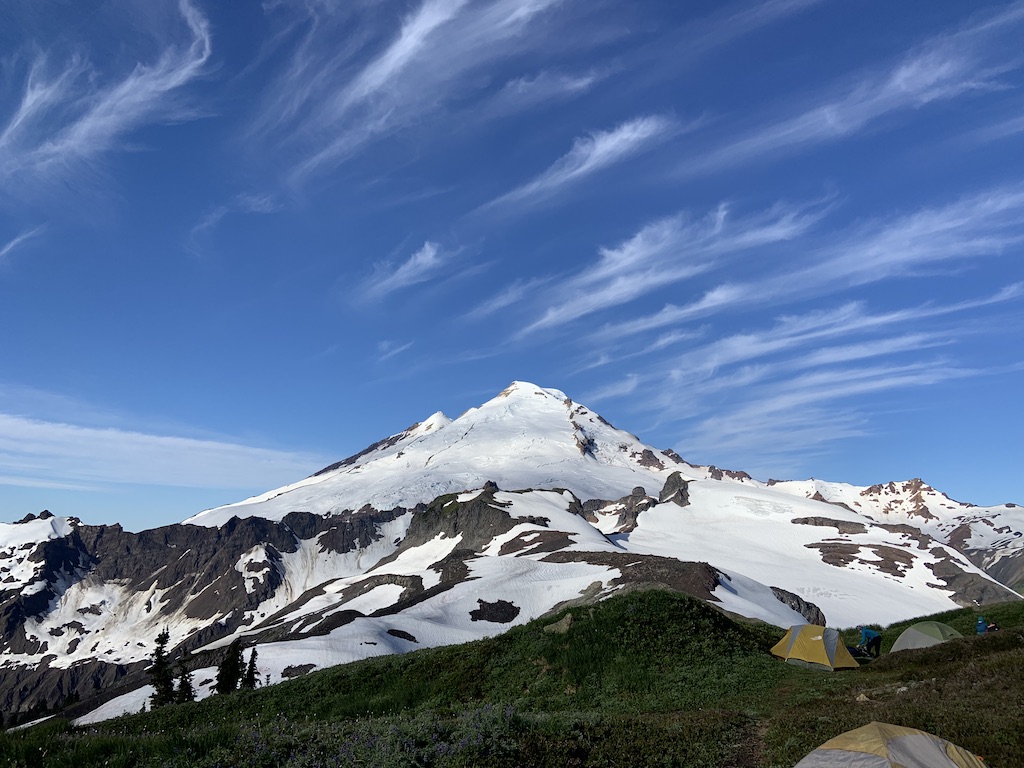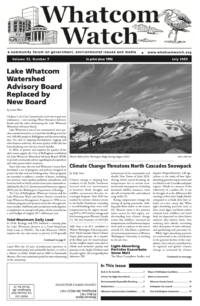by Sally Vaux
Climate change is shaping how residents of the Pacific Northwest interact with our environment as heatwave, flood, drought, and wildfire occurrences become increasingly frequent. May 2023 was marked by extreme climatic events in the Pacific Northwest, including a record-breaking heat wave with temperatures in the region exceeding 20°F to 30°F of their average and fires burning across Western Canada (1). The first heatwave of 2023 felt reminiscent of the catastrophic and deadly Heat Dome of June 2021, during which record-breaking air temperatures led to serious environmental consequences including increased wildfire instances, mass die-offs of marine life, and reduced crop yields (2).
Rising temperatures change the timing of spring snowmelt, shifting peak flows earlier in the season (3). Because snow is the primary water source for this region, understanding how climate change events like wildfires, increased air temperatures, and heatwaves impact snow and ice surfaces in the area is critical. Dr. Alia Khan, a professor of environmental science at Western Washington University, is working to do just that.
Light-Absorbing Particles Exacerbate Snow Melt
The Khan Cryosphere Studies and Aquatic Biogeochemistry Lab specializes in the study of how light-absorbing particles impact snow and ice albedo in the Cascades and polar regions. Albedo is a measure of the reflectivity of a surface (4). It can be thought of as the differences felt wearing a white shirt (high albedo) compared to a black shirt (low albedo) on a hot, sunny day. When light-absorbing particles such as dust, snow algae, and black carbon released from wildfires and fossil fuels are deposited on these frozen surfaces, they darken them, thus reducing their albedo, increasing their absorption of solar radiation, and quickening melt processes (5).
While light-absorbing particles are understood to be contributors to the general decline of the cryosphere, their relative contributions to regional and global climate change as estimated by climate models remain uncertain (6). As such, the Khan Lab seeks to fill important gaps in our understanding of this important climatic process by using ground samples of snow and ice to validate estimations of these particles from satellite and drone imagery and climate models.
In many parts of the world, including the Pacific Northwest, parts of the snowpack will turn red in the summer due to the presence of snow algae (often referred to as “watermelon snow”). Snow algae are naturally occurring organisms that bloom on snowpack surfaces in the summer months (7). In a 2021 study, Khan found snow algae to be a substantial accelerator of snowmelt at Bagley Basin, Mount Baker (8). During the summer of 2022, Khan and her team sampled a prominent, recurring algae patch on the Rainbow Glacier to assess how the bright red algae are impacting the snow albedo.
Tracking Glacier Decline in the North Cascades
To conduct alpine research on Mount Baker, Khan teamed up with Dr. Mauri Pelto, professor of environmental science at Nichols College and science director of the North Cascades Glacier Climate Project. Pelto started the project in 1983 and has monitored a selection of glaciers in the North Cascades every year since by measuring meltwater runoff, terminus behavior, and mass balance. Mass balance is a measure used by glaciologists to assess the health of a glacier by comparing the amount the glacier accumulates to the amount it loses year to year (9). If a glacier is losing more mass than it is accumulating, as many are in the North Cascades, then the glacier is in disequilibrium and will experience retreat and thinning (10).
In a paper published in 2018, Pelto estimated that glaciers in the North Cascades have lost at least 30 percent of their volume since 1984. Most of the glaciers he studies will be gone by the end of the century (11).
Pelto and his team survey the Sholes, Easton, and Rainbow Glaciers on Mount Baker, all of which are in decline. They report that the Easton Glacier’s terminus, which discharges into the Skagit River Watershed, has retreated 470 meters since 1990 (12). The Sholes Glacier’s terminus, discharging into the Nooksack River Watershed, has retreated an estimated 225 meters since 1984, with retreat intensifying in the years since 2015 (13).
The importance of glaciers for sustaining ecological and human life in the Pacific Northwest cannot be overstated. Freshwater reserves from these glaciers are critical natural reservoirs that support agriculture, fisheries, drinking water, hydroelectric power, and recreation (14). Runoff from glaciers is especially important for fish populations in the late summer, as it keeps water temperatures cool and sustains adequate flow necessary for fish survival (15).
Looking Ahead
Both Khan and Pelto and their teams will be in the mountains this summer studying snowpack and glacier decline in the North Cascades. The Khan Lab will continue their work by collecting snow samples and drone imagery to be analyzed for light-absorbing particle deposition throughout the algal bloom and wildfire seasons. As the North Cascade Glacier Climate Project enters its 40th year, Pelto predicts “significant mass loss” as this year’s melt season is already off to a rapid start, as explained in his American Geophysical Union blog, “From a Glacier’s Perspective” (16).
To adapt to and mitigate the effects of climate change in the Pacific Northwest, a comprehensive understanding of the problems and consequences at hand is imperative. Many people and organizations are working toward this locally, including Khan and Pelto. Both emphasize the importance of providing robust climate education for young scientists. For Pelto, this means training over 60 field assistants throughout the North Cascades Glacier Climate Project’s history. Meanwhile, Khan is working on a grant funded by the National Science Foundation to bring polar and high-alpine science to local classrooms through the use of 360° and satellite imagery, videos, GIS mapping exercises, and data analysis. The curriculum is currently being piloted at Western Washington University, where students get the chance to develop connections to rapidly changing remote places that they otherwise might not be able to.
As climate change continues to deplete the Pacific Northwest’s snowpack and glaciers, ongoing collaborative efforts between researchers, community organizers, tribes, and local and state governments are critical for building a sustainable path forward for our region’s ecosystems.
References
3. https://nca2018.globalchange.gov/chapter/3/
4. https://www.nature.com/articles/s41558-018-0296-5
5. https://www.nature.com/articles/s41558-019-0619-1
6. https://www.nature.com/articles/s41558-019-0619-1
7. https://www.nature.com/articles/s43247-023-00768-8
8. https://www.nature.com/articles/s43247-023-00768-8
9. https://glaciers.nichols.edu/north-cascade-glacier-mass-balance/
10. https://glaciers.nichols.edu/north-cascade-glacier-mass-balance/
11. https://www.mdpi.com/2073-4441/10/5/543
14. https://onlinelibrary.wiley.com/doi/10.1002/hyp.10012
15. https://link.springer.com/chapter/10.1007/978-3-319-05266-3_12
_______________________
Sally Vaux is an M.S. candidate at Western Washington University and a 2021 North Cascades Glacier Climate Project field assistant. As a member of the Khan Lab, her research focuses on how wildfires impact snow and ice albedo and meltwater quality and quantity in the Pacific Northwest and the polar regions. She is originally from Anacortes, WA.





























